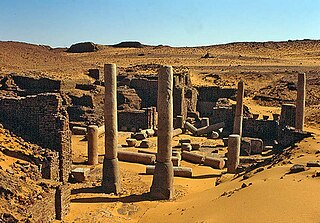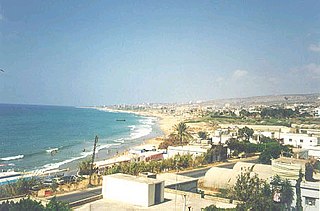
The Monastery in Ghazali is a medieval Christian monastery in the Bayuda Desert in northern Sudan. Probably founded by the Makurian king Merkurios in the late 7th century, it functioned until the 13th century. [1]

The Monastery in Ghazali is a medieval Christian monastery in the Bayuda Desert in northern Sudan. Probably founded by the Makurian king Merkurios in the late 7th century, it functioned until the 13th century. [1]
Almost all famous travelers visited the site in the 19th century. [2] The first excavations took place in the 1950s. From 2012 to 2018, research in Ghazali was conducted by a team of Polish archaeologists from the Polish Centre of Mediterranean Archaeology University of Warsaw, in cooperation with the National Corporation of Antiquities and Museums of Sudan. The project was directed by Artur Obłuski. At the same time, preparations were made for opening the site to visitors. [1]

Apart from the monastery, which is the main feature of the site in Ghazali, a settlement, cemeteries, and a metallurgical center with iron-smelting furnaces provided additional information on the daily life of the monks. [3]
The North Church in Ghazali with a basilical layout was mentioned already by 19th-century travelers and was first excavated by Peter Shinnie’s expedition. [4] It is a typical Makurian church. [1] [2] The younger South Church is built entirely of mud bricks. [1]
The monastery also encompasses several other buildings that served different functions. A free-standing building contained at first six, and then twelve dormitories. The triple bedrooms were small, measuring about 20 square meters. Remains of a staircase indicate there was a second floor. [5] A refectory (dining room) and installations for food production, such as a mill and an oil press, were found as well. [1]
There is evidence suggesting the presence of a pilgrimage movement in Ghazali. [1] [2]
Nubiology is the designation given to the primarily archaeological science that specialises in the scientific and historical study of Ancient Nubia and its antiquities.

Makuria was a medieval Nubian kingdom in what is today northern Sudan and southern Egypt. Its capital was Dongola in the fertile Dongola Reach, and the kingdom is sometimes known by the name of its capital.

Alodia, also known as Alwa, was a medieval kingdom in what is now central and southern Sudan. Its capital was the city of Soba, located near modern-day Khartoum at the confluence of the Blue and White Nile rivers.

Old Dongola is a deserted town in what is now Northern State, Sudan, located on the east bank of the Nile opposite the Wadi Howar. An important city in medieval Nubia, and the departure point for caravans west to Darfur and Kordofan, from the fourth to the fourteenth century Old Dongola was the capital of the Makurian state. A Polish archaeological team has been excavating the town since 1964.

Soba is an archaeological site and former town in what is now central Sudan. Three kingdoms existed in medieval Nubia: Nobadia with the capital in Faras, Makuria with the capital in Dongola, and Alodia (Alwa) with the capital in Soba. The latter used to be the capital of the medieval Nubian kingdom of Alodia from the sixth century until around 1500. E. A. Wallis Budge identified it with a group of ruins on the Blue Nile 19 kilometres (12 mi) from Khartoum, where there are remains of a Meroitic temple that had been converted into a Christian church.

Faras was a major city in Lower Nubia. The site of the city, on the border between modern Egypt and Sudan at Wadi Halfa Salient, was flooded by Lake Nasser in the 1960s and is now permanently underwater. Before this flooding, extensive archaeological work was conducted by a Polish archaeological team led by professor Kazimierz Michałowski.

Jieh is a seaside town in Lebanon with an estimated population of 5000, 23 km south of Beirut, in the Chouf district via a 20-minute drive along the Beirut to Sidon highway south of the capital. In Phoenician times it was known as Porphyreon and was a thriving natural seaport, which still functions today. The town is also known for its seven kilometre sandy beach, a rarity along Lebanon's mainly rocky coastline.

Metsamor site is the remains of an old fortress located to the southwest of the Armenian village of Taronik, in the Armavir Province.

Capitolias was an ancient city east of the Jordan River, and is identified with the modern village of Beit Ras in the Irbid Governorate in northern Jordan. Anciently it was a town of Coele-Syria.

Banganarti is a small village in Sudan, about half way between the third and fourth cataract of the Nile. It is situated 10 kilometres (6.2 mi) from Old Dongola, the capital of Makuria. Banganarti was an important Christian pilgrim center; the remains of a substantial medieval church are near the village (18.166736,30.784785).
Zuma (el-Zuma) is an archaeological site including a village and burial ground about 25 miles (40 km) downstream from Jebel Barkal in what is now Sudan. It lies about 10 kilometres (6.2 mi) south of El-Kurru, in the Napatan Region, on the right side of the Nile. The cemetery was visited several times by researchers in the last two hundred years, but there were only brief descriptions written, and no excavations. The tumuli field at el-Zuma has been known, erroneously, as the “El-Zuma Pyramids” since the first half of the 20th century. A plan was drawn up during the expedition of Karl Richard Lepsius. UNESCO inscribed Zuma's 20 hectares as a world cultural heritage site in 2003.
Kulubnarti is a 1 mile (1.6 km) long island in northern Sudan. Located on the Nile, around 100 miles (160 km) south of the Egyptian border, it is part of the village of Kulb.

The Throne Hall of Dongola, also known as the Mosque Building, is an archaeological site in Old Dongola, Sudan. It is a two-storey brick building situated on a rocky hill, overlooking the town and the Nile valley. It was originally built in the 9th century, serving as the richly adorned representative building of the Makurian kings. In 1317, during the period of Makurian decline, it was converted into a mosque, serving this purpose until it was closed and turned into a historic monument in 1969. Shortly afterwards Polish archaeologists from the Polish Centre of Mediterranean Archaeology of the University of Warsaw began to excavate the building. It has been described as possibly "the most important, symbolic edifice in the medieval history of Sudan". It is presently the oldest preserved mosque in Sudan.
Bahra 1 is an archaeological site in the Subiya region on the coast of Kuwait Bay (Kuwait) associated with the Ubaid culture. It is one of the earliest Ubaid culture settlements in the Persian Gulf region, about 5500–4900 BC.
North Asasif – is a part of the Theban Necropolis located on the bottom and sides of the valley, along the processional ways leading to the royal temples in Deir el-Bahari: temples of Mentuhotep II, Hatshepsut, and Thutmose III. It encompasses private tombs dating from the Middle Kingdom to the Ptolemaic period. Evidence has been found of strong ties between Asasif and Deir el-Bahari through the ages.
Aynuna – a village in northwestern Saudi Arabia, in the Tabuk Region, located about 5 km from the Red Sea coast, at the mouth of the Gulf of Aqaba. Archaeological remains discovered here are identified by most researchers with the Nabataean port of Leuke Kome, mentioned by Strabo, among others. It lay on a trade route; it is estimated that about 8-9 days were needed for a camel caravan to travel from Aqaba to Petra. The 300-km-long track led through the mountains but was fairly easy and safe.
Khirbet es-Sar is an archaeological site in Jordan. It lies in the western suburb of modern Amman, on the edge of a plateau. In the MEGA Jordan database, which stores information about sites located in Jordan, Khirbet es-Sar can be found under numbers 11304 and 3007.
El Detti is a village in the Northern Province of Sudan, on the right bank of the Nile between the Third and Fourth Cataracts. An Early Makurian cemetery is located there.
The monastery of the Archangel Gabriel at Naqlun – a Coptic monastery of the Archangel Gabriel located in northern Egypt, in the Faiyum Oasis, 16 km south-east of the city of Faiyum in the Libyan Desert. Since 1986, it is investigated by a team of researchers from the Polish Centre of Mediterranean Archaeology University of Warsaw, headed by Prof. Włodzimierz Godlewski. In 1997, the Church of St. Gabriel was restored.
Qumayrah Valley – a valley in northern Oman, in the Al-Hajar Mountains in the Ad Dhahirah Governorate. It stretches for about 10 kilometers between the villages of Ayn Bani Sa’dah (al-Ayn), Qumayrah and Bilt.
The list contains a selection of the latest publications on the research in the monastery written in English.